|
 PIPE RECOVERY BASICS
PIPE RECOVERY BASICS
Portions of this page are from Petroleum Engineer's Handbook
(PEH) online version.
Pipe recovery refers to a type of wireline operation to
assist
retrieval of drill pipe, tubing, or production casing
that is stuck in the hole. In this situation, the drilling
rig or pulling unit is unable to retrieve the pipe out of
the hole and a mitigation process called pipe recovery has
to be utilized. Pipe can become stuck in a well bore in both
open hole drilling operations as well as work-over
operations in cased hole. The goal of pipe recovery is to
retrieve as much pipe as possible to save the operator the
expense of replacing pipe and reduce the amount of lost hole
/ depth of well. Pipe recovery needs to be quick and precise
in the determination of free pipe vs stuck pipe. Every
minute a rig is down not operating is lost money to an oil
and gas operator.
Mitigation of stuck pipe is a step-by-step process:
1. Run free point indicator log on wireline to find top of stuck
pipe; this is the depth above which the pipe must be cut off so that
the free pipe can be retrieved.
2. Choose appropriate pipe cutting tool for the situation.
3. Run pipe cutter on wireline to a depth above free point depth
and cut the pipe.
4. Pull free pipe out of the hole.
5. Optional: run drill pipe with appropriate overshot to attempt
to retrieve remaining stuck pipe.
Close coordination between oil company engineer, rig crew, and
wireline crew is a critical part of a successful pipe retrieval
project.
 Causes Of Stuck Pipe
Causes Of Stuck Pipe
Situations that cause pipe to become stuck in open hole are:
Blowout: when the hydrostatic pressure of the drilling mud is lower
than the formation pressure, it is possible for formation fluids and
debris to move up the hole. This action creates an increase in pipe
friction and can wedge the pipe, causing it to become stuck in the
hole.
Differential Pressure: when the hydrostatic pressure of the drilling
mud is higher than the formation pressure, fluid begins to flow into
the formation. This causes the pipe to be sucked to the borehole
wall and unable to move.
Sloughing Hole: this happens when the stability of the borehole is
weak and breaks down. Once it breaks down, gravity goes to work
pulling the well debris down the wellbore, wedging the pipe in the
hole.
Swelling Formation: the formation reacts with the wellbore
fluids,acting like a sponge and swelling outward,, pinning the pipe
in the borehole wall.
Crooked or Bent Pipe: during drilling operations the pipe becomes
fatigued, causing the pipe to bend and torque up. This creates a
situation where the pipe pins itself on the walls of the well bore
and unable to rotate or be pulled out of the hole.
Key-seating: when the drill string becomes buried into the wellbore
walls in a deviation point or in a dog-leg area. Good indication of
this is the rig can push pipe in the hole but when pulling up it
starts pulling tight. If severe enough, the pipe will not be able
to move either direction. Example of this is pulling a rope over the
edge of a dirt hole. The more you pull on it the deeper the rope
cuts into the edge of the hole.
Common cased hole sticking issues:
Wrap Around: dual string completions, two strings of production
tubing are run in the hole with a dual packer to produce from
multiple intervals without comingling during production. When a work
over rig attempts to pull one string, they are unable to do so due
to the two strings wrapped together on bottom near the packers. The
pipe is unable to pull free from the packer.
Mud on back-side: when attempting to pull a single well completion,
the mud on the backside of the tubing has dried or settled out. This
creates a situation that is like having the pipe cemented in the
hole. The pipe is unable to move, and it is not possible to
circulate out due to density. Even if circulation hole is put in
pipe in area, you will be unable to pump in to remove debris.
Packer Seal: in a workover operation, the operator attempts to pull
the production string out of the packer. It is not uncommon in
older wells for the tubing to become affixed to the packer and
unable to move.
Collapsed Casing: as the name implies, the casing collapses due to
external strain or fatigue of the pipe. This pinches the production
string, not allowing the pipe to be moved.
Cemented String: in some older production practices, the tubing
string was cemented in place. The only way to remove is to perform
Pipe Recovery operation.
Junk: this pertains to a wide variety of possible causes. Often
debris from the well head installation wedges or pinches the pipe to
the casing wall. Some examples: bolts, wrenches, and other well bore
debris falling on top of the packer. Holes in production string can
allow formation debris to build up on the backside of the production
tubing.
 Free point Indicator ToolS
Free point Indicator ToolS
The free point tool is composed of several measurement components:
Casing collar locator (CCL),
Strain gauge to measure pipe stretch when an attempt is made to pull the
pipe,
Another to measure rotation or torque when an attempt is made to rotate
the pipe,
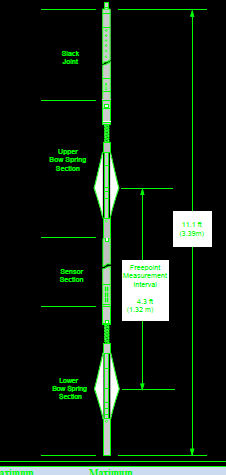 The
tool has an upper and lower part, each with motorized, spring
loaded, or magnetic anchors. The two parts are connected by a slack joint.
Relative motion, vertically or rotationally, between the two parts
is recorded by the sensors and sent uphole to the surface recorder.
Relative motion when tool is anchored, and rig is attempting to pull
or rotate the pipe, indicates free pipe. The
tool has an upper and lower part, each with motorized, spring
loaded, or magnetic anchors. The two parts are connected by a slack joint.
Relative motion, vertically or rotationally, between the two parts
is recorded by the sensors and sent uphole to the surface recorder.
Relative motion when tool is anchored, and rig is attempting to pull
or rotate the pipe, indicates free pipe.
Since this is a station-by-station measurement, common practice is to
take a reading near surface. With this set of stretch and rotation
data, and the pipe specs, an initial estimate of free point depth is
made. The tool is then run downhole from surface to some depth below
estimated free point, logging the casing collars on the way down.
Once the tool is in the stuck depth intervao, the
station-by-station
operation is performed moving uphole until the depth of 100% free pipe is determined more
precisely. This is the depth at which the pipe cutter will
be set after the free point tool is pulled out of the hole and laid
down. Some tools can be combined with back-off shots, saving rig
time.
Altermate tool designs may be in ose in some areas. An acoustic tool
identical to a cement bond log (CBL) may be used for drill pipe or
casing. As for cement, low amplitude at the receiver means stuck
pipe, high amplitude means free pipe.
Another type uses sensors that measure the changes in the pipe's
magnetic properties when stretch or torque are applied. It provides
fast and precise free-point location without the repetitive stop and
set measurements of traditional free point indicators..
 Back-off / String Shots
Back-off / String Shots
Back-off is the preferred method of freeing a drill string from a
stuck bottom hole assembly. It is the least destructive to the down
hole assembly and allows for multiple options for recovery if
desired. The basic concept is to simply unscrew the pipe at a
desired depth of 100% free pipe. The driller will apply “Left Hand
Torque” to the drill string and lock in with the tongs while holding
the string in the elevators. This is based on pipe type, torque
specs, collar connections, and desired back-off depth. A wireline
“string shot” is prepared based on the parameters for the current
operation. A specific amount of prima-cord is run in the hole to the
desired depth and detonated. This creates a hammer affect releasing
the tension in the collar and allowing the pipe to unscrew, freeing
the pipe and making it possible to move the pipe out of the hole,
once the wireline is pulled out of the hole and laid down.
 Casing and Pipe Cutting Tools
Casing and Pipe Cutting Tools
Casing cutters come in a variety of types and sizes to suit the
situation. Here is a brief description of the common varieties.
 Jet Cutter
Jet Cutter
A jet cutter is a radial shaped charge, allowing a blast to be
created in a 360deg direction to cut the pipe or tubing. Generally,
the tool diameter is close to the internal diameter of the pipe to
be cut.
 Example
of a Jet cutter tubing cut.==> Example
of a Jet cutter tubing cut.==>
Considerations:
** What pipe am I cutting? Best tool for the purpose?
If you are cutting light weight drill pipe and or tubing a jet
cutter will work well.
** Is the bottom hole assembly going to be fished?
The standard jet cutter will flare the pipe outward due to the
explosive pressure created, making fishing operations difficult and
require an extensive remedial operation prior to fishing. Several
pipe trips will be required to dress off or mill the top of the fish
enough to allow an over shot to be run. If fishing and a jet cutter
is preferred, consider a Premium cutter. This cutter will cut the
pipe cleanly with minimal amount of pipe distortion, making it
easier to fish with a burn over mill and over shot to dress off top
prior to latching fish.
** Will I be able to maintain tension on the drill string /
production string during cutter ops?
Standard cutters require tension on the pipe to insure a complete
cut. Even then, there are some situations where the pipe will not
be cut completely, and an addition cutter run will be required. If
so, do not cut in same place, move up the hole to fresh pipe to
re-attempt cut.
** Is there enough stand-off distance of the intended string to be
cut?
It is possible for a jet cutter to damage the casing if cutting
pipe that has little to no collar connection stand-off.
** Are there any restrictions inside the assembly that would prevent
the cutter from getting to depth?
The jet cutter is a large diameter tool, specifically designed to
cut the drill pipe/tubing desired. If there are any restrictions,
jewelry, or couplers the ID measurements need to be reviewed before
running in.
 Chemical Cutter
Chemical Cutter
A chemical cutter is a controlled high-pressure dispersion of
bromine trifluoride. It creates a highly corrosive environment when
mixed with water, causing a chemical reaction to rust the pipe at an
accelerated rate. There is no debris and no pipe distortion after
cutting, making fishing operations less complicated.
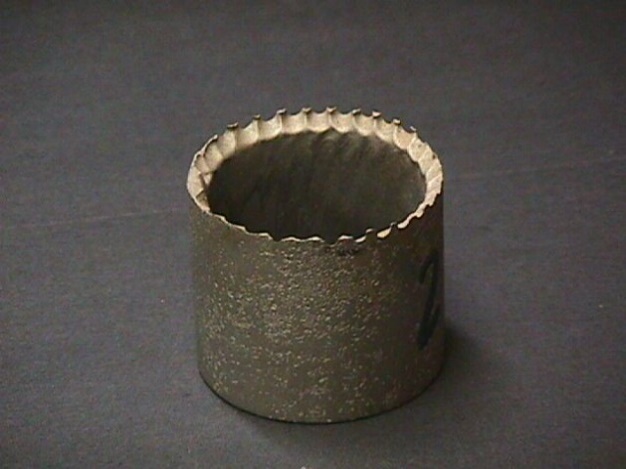 Example
of a Chemical Cutter tubing cut. ==> Example
of a Chemical Cutter tubing cut. ==>
Considerations:
Does not work in mud environments. Sensitive to high hydrostatic
pressures.
 Radial Cutting Torch
Radial Cutting Torch
A radial cutting torch is a plasma cutter that creates a clean cut
of various pipe types. It does not require fluid in the well or
clear fluid. It works in almost all fluid systems currently in use
for drilling or production operations. It is a non-explosive tool
and does not require any special shipping restrictions for
commercial air lines. This reduces cost and delays getting tools to
a well site.
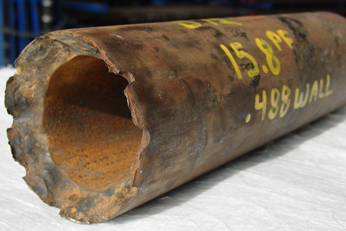 Example
of Radial Cutting Torch. ==> Example
of Radial Cutting Torch. ==>
Considerations:
Cost of radial cutting torch. Timing of availability for
application.
 Split Shot
Split Shot
The split shot is a linear shape charge designed to split a collar
connection, allowing the pipe to slip out of the box connection.
Magnets are run in conjunction to hold tool in position while cut is
made. It is a great option when ID restriction prevents a
traditional jet cutter from being run, due to the slim design of the
tool. The main drawback is the tool must be positioned across the
collar to be effective.
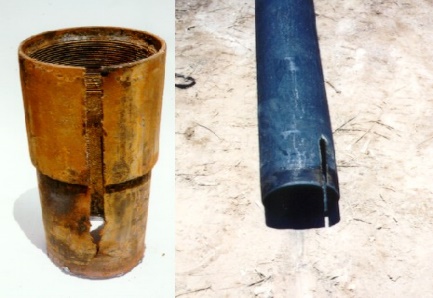 Example
of a Split shot cut. ==> Example
of a Split shot cut. ==>
Considerations:
** Can a jet cutter be utilized?
** Is well deviated and is it possible to accurately place tool in
desired location?
 Severing Tool / Colliding Tool
Severing Tool / Colliding Tool
A severing tool or colliding tool is a last resort application for
cutting pipe. It is primarily used on heavy weight drill pipe or
drill collars. It is completely destructive and blows the pipe apart
(bomb downhole). There is two explosive charges at either end of
the tool. When detonated they both explode creating a shock wave
that meets in the middle section of the tool blasting the pipe in
two.
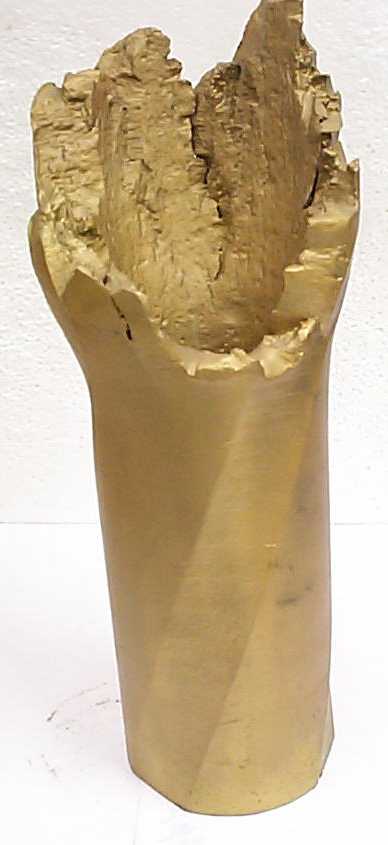 Example
of Severing Tool ==> Example
of Severing Tool ==>
Considerations:
** Is BHA being left in hole?
Extremely difficult to fish.
|

